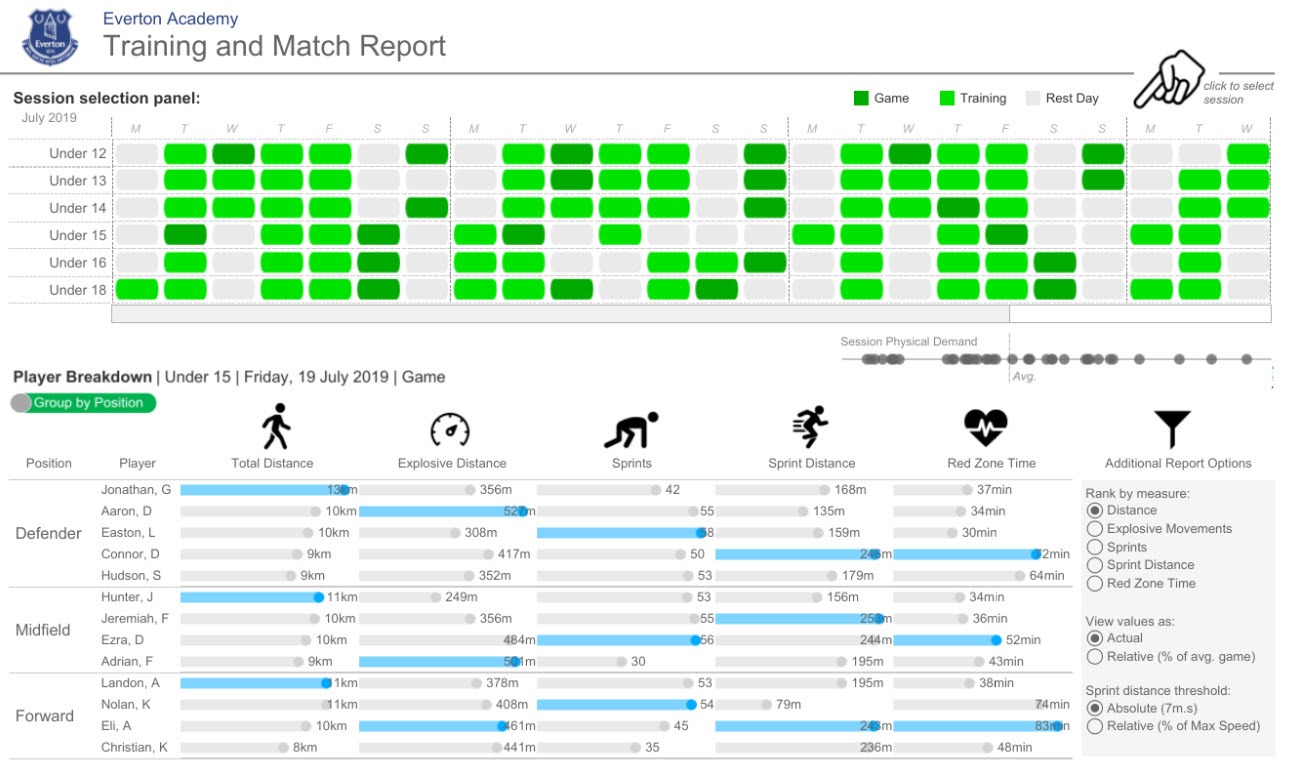

Everton FC Academy boosts player performance and potential with Tableau
Data-driven development plans boost player performance, creating stars of the future
Deeper insights in sports science empower coaches to nurture young players to their full potential
Better collaboration with data enables the scouting network to find and recruit the right talent
Professional football is one of the most competitive, lucrative industries in the world. The European market alone is worth over £25bn, and the demands on clubs to compete on and off the pitch grow with every season. Football clubs’ academies need to ensure that promising players graduate to the first-team in order to support sustained success on the field.
The Everton Academy is where Everton Football Club nurtures its exceptional young talent towards the first-team, supporting them in their journeys towards the professional game. Here, the Academy’s Nick Coleman, Sam Bailey, and Owen O'Connor discuss how Tableau is helping Everton drive player performance and recruit the very best talent.
Professional football is an incredibly competitive field. Our data-culture empowers the Academy to compete at the highest level.
What brought the Academy to Tableau?
Prior to Tableau, our biggest challenge was combining and exploring large amounts of non-uniform datasets. Too much time was devoted to processing the data, not enough on analysing it to develop our young players. Different functions like recruitment, coaching, and sports science were using different systems, the data was siloed, and we couldn’t collaborate as we’d have liked. This meant key insights that would improve the team’s performance were missed.
So where did you start?
Sports science drove the initial Tableau deployment. They collected a mass of data on players – GPS tracking, fitness data, injury history – and used visual analytics to share instant, easily digestible insights with coaches, players, and other Academy functions. When we saw the positive impact this was having on players’ development, we were inundated with requests for similar analysis.
How did you scale Tableau across the Academy?
Our first step was to create a centralised analytics team within the Academy. By connecting the key player databases from departments like recruitment, coaching, performance analysis and sports science, employees are now able to explore an incredible amount of rich intelligence across the Academy. Those connections are providing insights that couldn’t be spotted previously, transforming how the Academy progresses upcoming talent.
Because Tableau allows such intuitive, interactive analysis, the performance analysts and coaches can share these insights with players for post-match analysis and individual feedback with ease.
How is Tableau improving player performance?
As part of our performance analysis strategy, we rely on Tableau to analyse Under-18 Everton Academy players compared to our opposition, studying measures like possession, completed passes, pass accuracy, shots on target - in short, everything. We can monitor this at a team level or drill down into individuals, for example comparing forward passes player X made in the final third, versus player Y.
From there, we can look at why that’s the case, and define individual plans and team tactics ahead of our next match. Because Tableau allows such intuitive, interactive analysis, the performance analysts and coaches can share these insights with players for post-match analysis and individual feedback with ease. Tableau is highly adaptable and flexible, meaning we’re confident our system can handle any future demands that professional football might throw at us.

Where is Tableau having the biggest impact when it comes to developing young players?
We want to give our young, exceptional talent a pathway to the first team – and Tableau is instrumental. We recognise that adolescent players mature at a different rate, and that their form will fluctuate at different times in their growth. Without data-driven insights, it’s easy to assume any change in the player is a long-term performance issue, leading to them being released from the Academy.
Now, with Tableau’s help, we have a granular view of their entire profile, from growth and development, to on-pitch performance and player care. Using this holistic view, we can pinpoint why a player’s form is fluctuating. More importantly, we can then create bespoke programmes for each individual to continue their progress. We’re really proud to see so many Academy players graduate to the first-team.
Analysing all this information at scale helps determine future Academy recruitment strategies – by organising our scouting network and prioritising key areas, we can act quicker and more decisively to recruit the right talent.
How is Tableau helping the Academy recruit the right players?
The Academy has a large intake from grassroots football, and our scouts are out there in all weathers measuring and benchmarking player performance. Tableau ensures that this knowledge is no longer solely in people’s heads but is accessible, and can be explored and interrogated in great detail.
In Professional Recruitment we have more information at hand to make informed decisions. We can dive deeper into historical match reports and player performances, meaning we can challenge opinion and gut instinct with key insights and trends we’re uncovering. Analysing all this information at scale helps determine future Academy recruitment strategies – by organising our scouting network and prioritising key areas, we can act quicker and more decisively to recruit the right talent.
Why is developing a data-culture so important to Everton?
Professional football is an incredibly competitive field. Our data-culture empowers the Academy to compete at the highest level, and it’s maturing all the time. Each department uses Tableau to support their decision-making, and we have data champions to provide training and drive adoption. We’re working more collaboratively than ever before and sharing insights with ease. Ultimately, this is helping our young players maximise their potential, creating sustained success on the pitch.